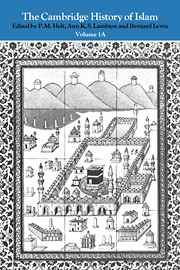Book contents
- Frontmatter
- Introduction
- Part I The rise and domination of the Arabs
- Part II The coming of the steppe peoples
- 1 The disintegration of the caliphate in the east
- 2 Egypt and Syria
- 3 Anatolia in the period of the Seljuks and the Beyliks
- 4 The emergence of the Ottomans
- Part III The central Islamic lands in the Ottoman period
- References
2 - Egypt and Syria
from Part II - The coming of the steppe peoples
Published online by Cambridge University Press: 28 March 2008
- Frontmatter
- Introduction
- Part I The rise and domination of the Arabs
- Part II The coming of the steppe peoples
- 1 The disintegration of the caliphate in the east
- 2 Egypt and Syria
- 3 Anatolia in the period of the Seljuks and the Beyliks
- 4 The emergence of the Ottomans
- Part III The central Islamic lands in the Ottoman period
- References
Summary
To the end of the Fatimid caliphate
For more than two centuries after the Arab conquest, Egypt was a province of the Islamic empire. Her capital was Fustāt, a garrison centre established by the conquerors; her rulers were a line of Arab governors, sent by the caliphs in the East. Though the main centres of the empire lay in Asia, the province of Egypt was not unimportant. Her rich corn harvest helped to supply the needs of hungry Arabia; her revenues enriched the imperial exchequer; her ports, her camps, her marts and her schools were the bases from which the fleets and armies, the merchants and missionaries of Islam drove westward and southward, by the Mediterranean and the Red Sea, and far into Africa. Though divided into administrative and fiscal sub-districts, Egypt was highly centralized. The unified valley of a great river, she was easily controlled, and kept firmly under the authority of the central, imperial power.
The Syrian lands, stretching from Sinai to the foothills of Taurus, present a different picture. At first, like Egypt, a conquered province of the Medina caliphate, Syria herself became the seat of empire under the Umayyads—only to revert to provincial status after their fall, and the transfer of the imperial capital to ‘Irāq. But here there was no centralized unity like that of Egypt. In the Syrian lands, a broken landscape of mountains, valleys, rivers, plains and deserts, with ancient and distinctive cities, held a population of great diversity, and imposed a fragmentation of government—a division into widely separated districts and regions, ruled by different authorities and often by different means.
- Type
- Chapter
- Information
- The Cambridge History of Islam , pp. 175 - 230Publisher: Cambridge University PressPrint publication year: 1977
References
- 2
- Cited by



